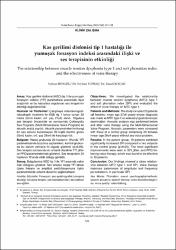| dc.contributor.author | Bengisu, Serkan | |
| dc.contributor.author | Topbaş, Seyhun | |
| dc.contributor.author | Koçak, İsmail | |
| dc.date.accessioned | 2019-10-22T20:06:55Z | |
| dc.date.available | 2019-10-22T20:06:55Z | |
| dc.date.issued | 2008 | |
| dc.identifier.issn | 1300-7475 | |
| dc.identifier.uri | http://www.trdizin.gov.tr/publication/paper/detail/T0RjM09UTXo= | |
| dc.identifier.uri | https://hdl.handle.net/11421/22125 | |
| dc.description.abstract | Amaç: Kas gerilimi disfonisi (KGD) tip 1 ile yumuşak fonasyon indeksi (YFİ) parametresi arasındaki ilişki araştırıldı ve bu hastalara uygulanan ses terapisinin etkinliği değerlendirildi. Hastalar ve Yöntemler: Çalışmaya videolarengostroboskopik inceleme ile KGD tip 1 tanısı konan 20 hasta (tümü kadın; ort. yaş 27±6) alındı. Olgulara ses terapisi öncesinde ve sonrasında Çokboyutlu Ses Programı (Multi-Dimensional Voice Program) ile akustik analiz yapıldı. Akustik parametreler herhangi bir ses sorunu bulunmayan 20 kişilik kontrol grubu (tümü kadın; ort. yaş 28±4) ile karşılaştırıldı. Bulgular: Hasta grubunda 20 hastanın 19’unda YFİ parametresinde bozulma saptanırken, kontrol grubunda bu durum yalnızca iki olguda gözlendi (p<0.05). Ses terapisi sonrasında en anlamlı düzelme YFİ, jitter ve PPQ parametrelerinde gözlendi. Ses terapisinin 20 hastanın 19’unda etkili olduğu görüldü. Sonuç: Bulgularımız KGD tip 1 ile YFİ arasında yakın ilişki olduğunu gösterdi. Ses terapisi, başta YFİ olmak üzere frekans ve amplitüd pertürbasyonuna ilişkin parametrelerde anlamlı düzelme sağlamaktadır. | en_US |
| dc.description.abstract | Objectives: We investigated the relationship between muscle tension dysphonia (MTD) type 1 and soft phonation index (SPI) and evaluated the effect of voice therapy on MTD type 1. Patients and Methods: The study included 20 patients (all females; mean age 27+-6 years) whose diagnosis was made as MTD type 1 on videolaryngostroboscopic examination. Acoustic analysis was performed before and after voice therapy using the Multi-Dimensional Voice Program. Acoustic parameters were compared with those of a control group comprising 20 females (mean age 28+-4 years) without any voice problem. Results: In the patient group, 19 patients exhibited significantly increased SPI compared to two subjects in the control group (p>0.05). The most significant improvements were seen in SPI, jitter, and PPQ following voice therapy, which was found to be effective in 19 patients. Conclusion: Our findings showed a close relationship between MTD type 1 and SPI. Voice therapy improves parameters of amplitude and frequency perturbations, in particular SPI. | en_US |
| dc.language.iso | tur | en_US |
| dc.rights | info:eu-repo/semantics/openAccess | en_US |
| dc.subject | Cerrahi | en_US |
| dc.title | Kas gerilimi disfonisi tip 1 hastalığı ile yumuşak fonasyon indeksi arasındaki ilişki ve ses terapisinin etkinliği | en_US |
| dc.title.alternative | The relationship between muscle tension dysphonia type 1 and soft phonation index and the effectiveness of voice therapy | en_US |
| dc.type | article | en_US |
| dc.relation.journal | Kulak Burun Boğaz İhtisas Dergisi | en_US |
| dc.contributor.department | Anadolu Üniversitesi, Sağlık Bilimleri Fakültesi, Dil ve Konuşma Terapisi Bölümü | en_US |
| dc.identifier.volume | 18 | en_US |
| dc.identifier.issue | 3 | en_US |
| dc.identifier.startpage | 131 | en_US |
| dc.identifier.endpage | 138 | en_US |
| dc.relation.publicationcategory | Makale - Ulusal Hakemli Dergi - Kurum Öğretim Elemanı | en_US] |


















